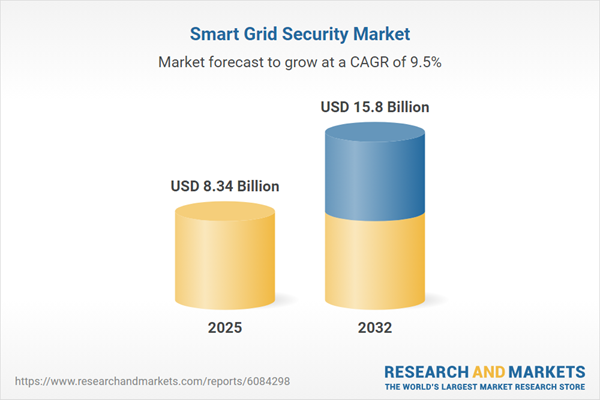Speak directly to the analyst to clarify any post sales queries you may have.
The Smart Grid Security Market is quickly evolving, shaped by increasing digitalization, decentralized energy assets, and advancing regulatory standards. Senior executives face mounting pressure to protect critical infrastructure while ensuring operational resilience and future-readiness.
Market Snapshot: Smart Grid Security Market Growth and Outlook
The Smart Grid Security Market grew from USD 7.65 billion in 2024 to USD 8.34 billion in 2025 and is set to continue expanding at a CAGR of 9.48%, ultimately reaching USD 15.80 billion by 2032. Rapid adoption of advanced security solutions is driven by the need to defend modern, interconnected grid systems against emerging threats. Escalating regulatory expectations, complex supply chains, and widespread digital transformation are collectively fueling demand for integrated, future-proof grid protection strategies.
Scope & Segmentation
This research rigorously examines the entire value chain and key innovation areas within the smart grid security market. Segmentation is structured to reflect real-world procurement and deployment scenarios critical to strategic planning.
- Product Type: Antivirus/Antimalware, Distributed Denial of Service, Encryption, Firewall, Identity & Access Management (IAM), Intrusion Detection System/Intrusion Prevention System (IDS/IPS), Security & Vulnerability Management (SVM).
- Security Type: Application Security, Database Security, Endpoint Security, Network Security.
- Services: Consulting, Education & Training, Support & Maintenance.
- Deployment Model: Cloud‑Based Solutions, On‑Premise Solutions.
- End Uses: Distributed Energy Resource (DER) Operators, Government & Regulatory Bodies, Industrial & Commercial Energy Consumers, Renewable Energy Providers, Utility Companies & Grid Operators.
- Regions: Americas: United States, Canada, Mexico, Brazil, Argentina, Chile, Colombia, Peru. Europe, Middle East & Africa: United Kingdom, Germany, France, Russia, Italy, Spain, Netherlands, Sweden, Poland, Switzerland, United Arab Emirates, Saudi Arabia, Qatar, Turkey, Israel, South Africa, Nigeria, Egypt, Kenya. Asia-Pacific: China, India, Japan, Australia, South Korea, Indonesia, Thailand, Malaysia, Singapore, Taiwan.
- Key Companies: ABB Ltd., Honeywell International Inc., Apex Energy Security Solutions, Cisco Systems, Inc., Eaton Corporation plc, Hitachi, Ltd., Infineon Technologies AG, Itron, Inc., Landis+Gyr AG, Microchip Technology Inc., Mitsubishi Electric Corporation, Rockwell Automation, Inc., Schneider Electric SE, Siemens AG, STMicroelectronics N.V., Texas Instruments Incorporated, The General Electric Company.
Key Takeaways for Senior Decision-Makers
- Integrated cybersecurity frameworks have become indispensable, mitigating vulnerabilities across both legacy and new digital assets within utility networks.
- The rapid rise of distributed energy resources and cloud-based control platforms requires adaptive, scalable protection models that extend beyond traditional perimeter defenses.
- Regulatory evolution compels organizations to adopt standardized protocols and rigorous compliance measures, impacting procurement, training, and ongoing investments.
- Technology vendors are responding with modular solutions, making possible a defense-in-depth approach tailored to diverse operational scenarios and regional requirements.
- Regional market shifts highlight the importance of flexible security architectures, with established infrastructure in the Americas, cross-border collaborations in EMEA, and agile, cloud-first deployments in Asia-Pacific.
- Strategic alliances between grid operators, technology solutions providers, and regulatory bodies are strengthening resilience, fostering innovation, and streamlining deployment across the ecosystem.
Tariff Impact on the Smart Grid Security Market
New United States tariffs introduced in 2025 have notably impacted supply chains and component pricing for smart grid security solutions. Some vendors have adjusted strategies toward domestic sourcing or reengineered products to reduce reliance on imported components. Increased supply chain constraints have also elevated the relevance of software-centric security approaches and scalable deployment models, providing utilities with greater cost transparency and flexible budgeting options.
Methodology & Data Sources
This report integrates primary research from senior industry leaders and experts through in-depth interviews, supplemented by comprehensive secondary reviews of published technical documentation and regulatory filings. Triangulation of quantitative data through proprietary and public databases ensures accuracy and consistency across all insights and recommendations.
Why This Report Matters
- The analysis enables executive teams to benchmark smart grid security investments by technology, segment, and region, supporting informed strategic decision-making.
- It highlights the risks and opportunities in a rapidly changing market where compliance, supply chain agility, and digital resilience are crucial for future success.
- Customized segmentation and actionable recommendations empower stakeholders to align security strategies with specific operational and regional needs.
Conclusion
Senior leaders navigating the smart grid security market must prioritize cohesive, adaptive strategies that align investments with evolving technology and regulatory dynamics. Those prepared to advance collaborative partnerships and robust protection architectures will be best positioned for sustainable growth and resilience.
Table of Contents
3. Executive Summary
4. Market Overview
7. Cumulative Impact of Artificial Intelligence 2025
Companies Mentioned
The companies profiled in this Smart Grid Security market report include:- ABB Ltd.
- Honeywell International Inc.
- Apex Energy Security Solutions
- Cisco Systems, Inc.
- Eaton Corporation plc
- Hitachi, Ltd.
- Infineon Technologies AG
- Itron, Inc.
- Landis+Gyr AG
- Microchip Technology Inc.
- Mitsubishi Electric Corporation
- Rockwell Automation, Inc.
- Schneider Electric SE
- Siemens AG
- STMicroelectronics N.V.
- Texas Instruments Incorporated
- The General Electric Company
Table Information
| Report Attribute | Details |
|---|---|
| No. of Pages | 197 |
| Published | November 2025 |
| Forecast Period | 2025 - 2032 |
| Estimated Market Value ( USD | $ 8.34 Billion |
| Forecasted Market Value ( USD | $ 15.8 Billion |
| Compound Annual Growth Rate | 9.4% |
| Regions Covered | Global |
| No. of Companies Mentioned | 18 |









